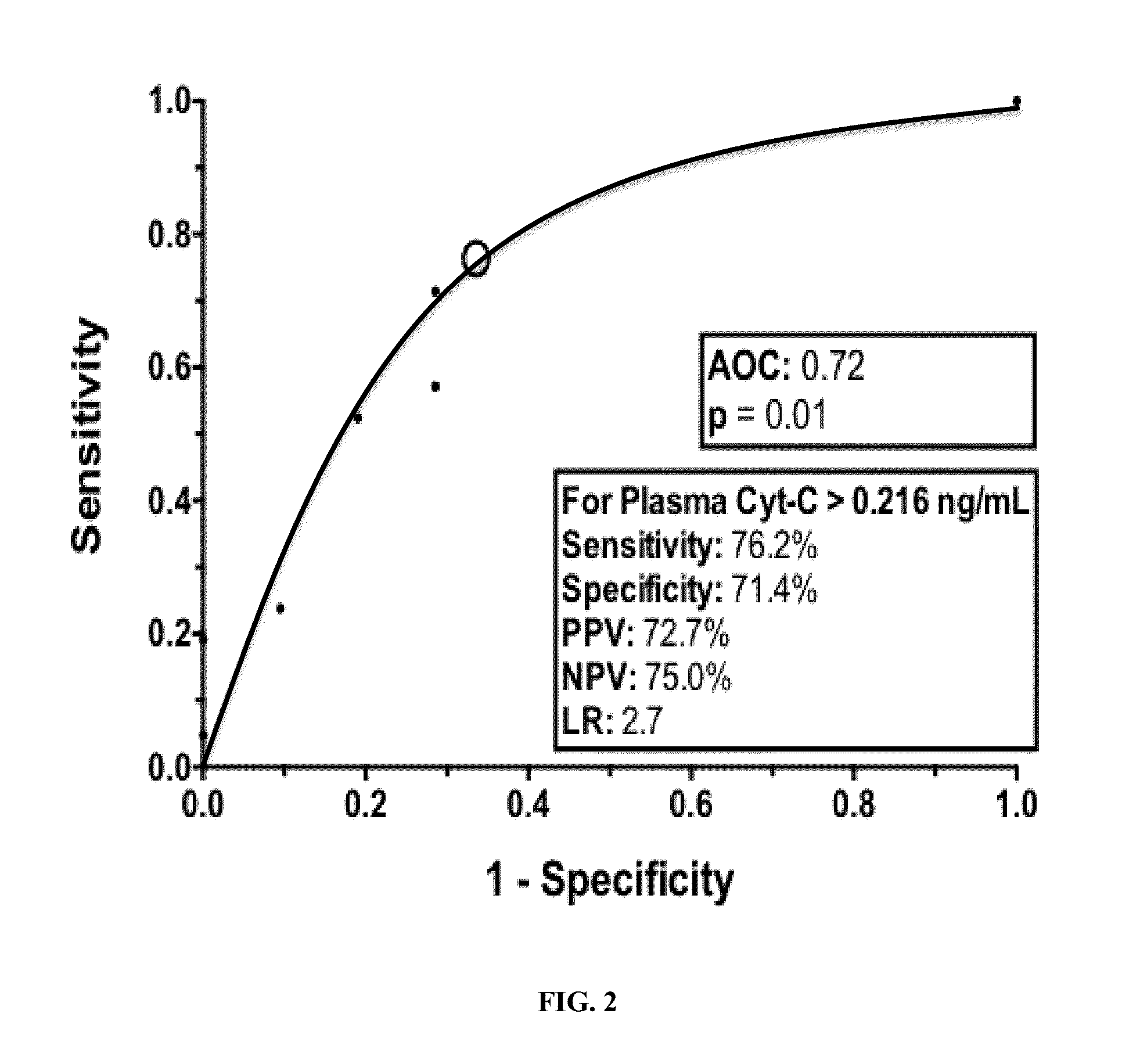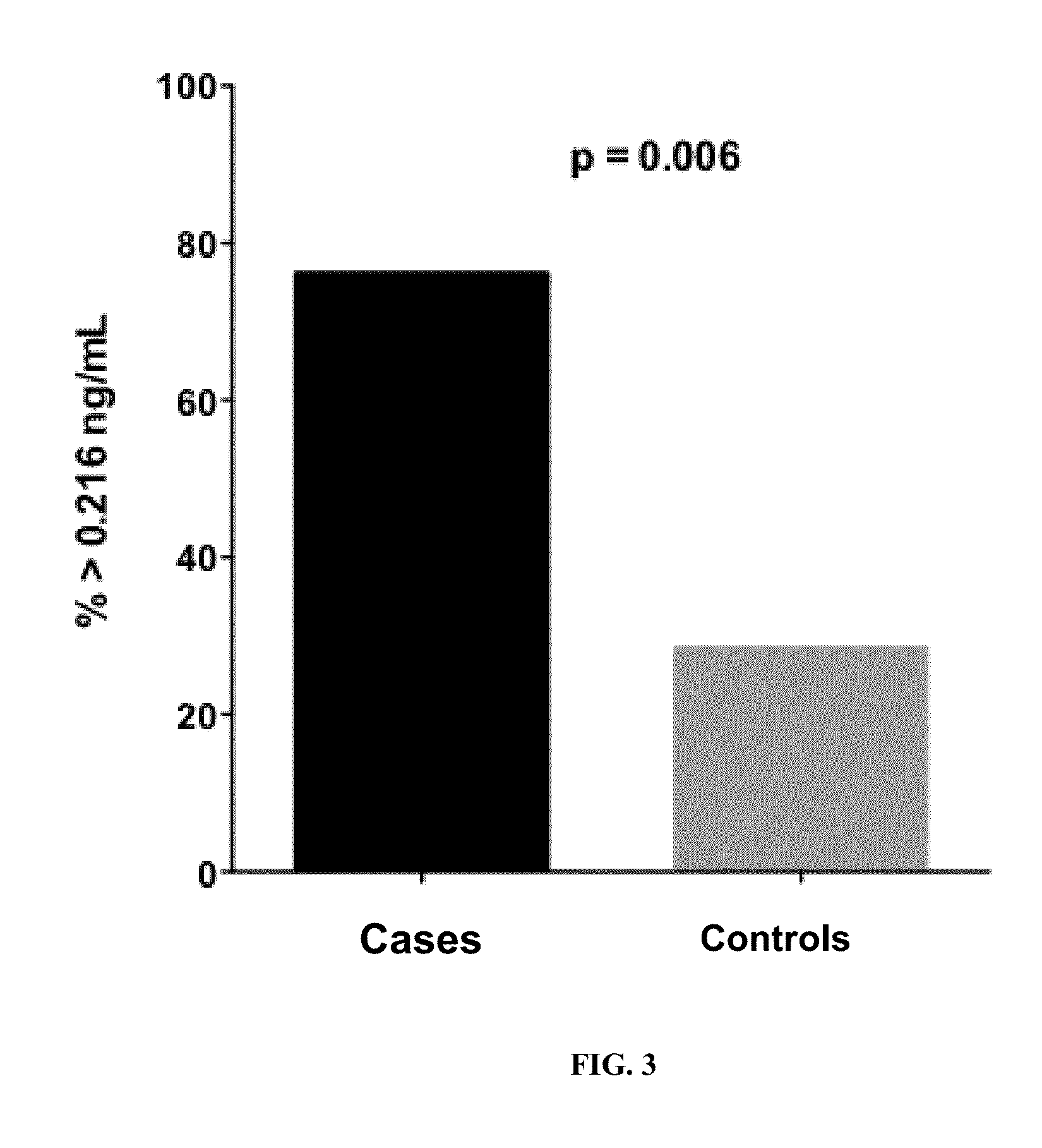Plasma cytochrome c as a biomarker for mitochondrial toxicity during antiretroviral therapy
a technology of antiretroviral therapy and cytochrome c, which is applied in the field of antiretroviral drug toxicity biomarkers, can solve the problems of reducing affecting the detection accuracy of mitochondrial toxicity, so as to improve the level of apoptotic protein and detect antiretroviral drug toxicity
- Summary
- Abstract
- Description
- Claims
- Application Information
AI Technical Summary
Benefits of technology
Problems solved by technology
Method used
Image
Examples
example 1
Demographic and Clinical Characteristics of Study Participants
[0083]Twenty-one pairs of cases and controls were enrolled. Various characteristics of the study participants are presented in table 1. Each group contained 38% females, with a mean age of 53 (+ / −7) years and was predominantly African American (71%), with 24% white non-Hispanic, and 5% Hispanic individuals. There was no difference between the groups with regards to CD4 count or viral load. Viral load was undetectable (<20 copies / mL) for 71% of cases and 86% of controls (p=0.45). In the GEE model, viral load was not correlated with Cyt-C levels. Past and present nucleoside / tide analogue exposure time was similar between the two groups (Table 1). Current nucleoside / tide analogues in use were Truvada (tenofovir / emtricitabine), Atripla (efavirenz / tenofovir / emtricitabine), Combivir (lamivudine / zidovudine), Epivir (lamivudine), and Trizir (abacavir / lamivudine / zidovudine). The use of an integrase inhibitor, protease inhibitor(s)...
example 2
Plasma Cyt-C Statistics Between Cases and Controls
[0084]The results presented herein demonstrate that the level of Cyt-C in the plasma of HIV patients is statistically different between subjects experiencing or not HAART toxicity.
[0085]The difference in the median plasma concentration of Cyt-C was statistically significant between cases (0.65 ng / mL, range 0.216 ng / mL had a sensitivity of 76.2% (95% CI 0.52, 0.91) and a specificity of 71.4% (95% CI 0.47, 0.88) to detect the cases (FIG. 2). Using >0.216 ng / mL of plasma Cyt-C as the definition and reference value of a positive result, a significantly higher proportion of cases (76.2%) than controls (28.6%) had a positive result (McNemar test, p0.216 ng / mL compared with controls (p=0.01). Furthermore, when the single outlier case and its matched control were removed from analysis, the difference in Cyt-C plasma concentration remained significant between the two groups (p<0.02).
example 3
Plasma Cyt-C as a Biomarker for ART-Induced Mitochondrial Toxicity in HIV-Infected Patients on HAART
[0086]The present invention is the first to examine the utility of plasma Cyt-C as a biomarker of ART-induced mitochondrial toxicity in HIV infected patients on ART. Various concentration cutoffs of Cyt-C were analyzed to determine which might be the best combinations of sensitivity and specificity, should it be used as a clinical test. No study to date has reported these test characteristics for plasma Cyt-C in any disease state. Only one study using a mouse model of drug induced hepatic toxicity has demonstrated serum levels of 50 to 150 ng / mL of Cyt-C, with the saline treated controls demonstrating levels of 0 to 50 ng / mL, as measured by ELISA (Miller et al., J Appl Toxicol 2008,28:815-828). In this and other drug toxicity studies, medications were being given with the intention of inducing high levels of cellular death, which may explain why the Cyt-C concentrations were higher t...
PUM
| Property | Measurement | Unit |
|---|---|---|
| Toxicity | aaaaa | aaaaa |
Abstract
Description
Claims
Application Information
 Login to View More
Login to View More - R&D
- Intellectual Property
- Life Sciences
- Materials
- Tech Scout
- Unparalleled Data Quality
- Higher Quality Content
- 60% Fewer Hallucinations
Browse by: Latest US Patents, China's latest patents, Technical Efficacy Thesaurus, Application Domain, Technology Topic, Popular Technical Reports.
© 2025 PatSnap. All rights reserved.Legal|Privacy policy|Modern Slavery Act Transparency Statement|Sitemap|About US| Contact US: help@patsnap.com



